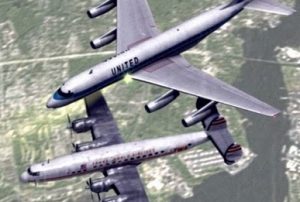
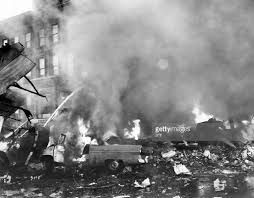 With the thousands of airplanes in the air at any moment, one might think that daily accidents would be common place, but in reality, air travel is actually very safe. Nevertheless, it is not without its tragedies. What tends to amaze me, however, is the fact that relatively few ever seem to crash in a city, even though the airports are usually very near cities. Still, there is not a perfect record of missing the cities, when it comes to plane crashes either, and when a plane crashes in a city, you know that the death toll will be higher, and more than likely will include people on the ground, who were just going about their day, completely unaware of the danger they were in.
With the thousands of airplanes in the air at any moment, one might think that daily accidents would be common place, but in reality, air travel is actually very safe. Nevertheless, it is not without its tragedies. What tends to amaze me, however, is the fact that relatively few ever seem to crash in a city, even though the airports are usually very near cities. Still, there is not a perfect record of missing the cities, when it comes to plane crashes either, and when a plane crashes in a city, you know that the death toll will be higher, and more than likely will include people on the ground, who were just going about their day, completely unaware of the danger they were in.
Such was the case on this day, December 16, 1960, in New York City, when two commercial airliners, a United 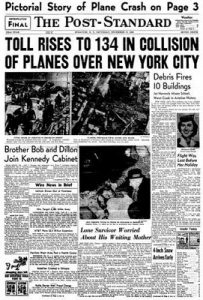 DC-8 from Chicago, that was heading to Idlewild Airport…now renamed John F Kennedy International Airport, in southern Queens, and a TWA Super Constellation from Dayton, Ohio that was heading to LaGuardia Airport in northern Queens, collided over the city, killing 134 people in the planes and on the ground. This remains the only such accident to occur over a major US city to this day. It was snowing that morning, and the United flight had been put into a holding pattern. Unfortunately, the pilot miscalculated the location of the pattern, the plane came directly into the path of the TWA flight, who was on approach to LaGuardia Airport. There were 128 people onboard the two planes, and all of them, except eleven year old Stephen Baltz were killed on impact. The boy would die from his injuries the next day, but he was lucid enough to give a brief account of the accident, saying that, “It looked like a picture out of a fairy book. Then all of a sudden there was an explosion. The plane started to fall and people started to scream. I held on to my seat and then the plane crashed.”
DC-8 from Chicago, that was heading to Idlewild Airport…now renamed John F Kennedy International Airport, in southern Queens, and a TWA Super Constellation from Dayton, Ohio that was heading to LaGuardia Airport in northern Queens, collided over the city, killing 134 people in the planes and on the ground. This remains the only such accident to occur over a major US city to this day. It was snowing that morning, and the United flight had been put into a holding pattern. Unfortunately, the pilot miscalculated the location of the pattern, the plane came directly into the path of the TWA flight, who was on approach to LaGuardia Airport. There were 128 people onboard the two planes, and all of them, except eleven year old Stephen Baltz were killed on impact. The boy would die from his injuries the next day, but he was lucid enough to give a brief account of the accident, saying that, “It looked like a picture out of a fairy book. Then all of a sudden there was an explosion. The plane started to fall and people started to scream. I held on to my seat and then the plane crashed.”
The TWA plane crashed onto Miller Field, a military airfield on Staten Island. The United flight, which was missing its right engine and part of a wing, came down in the middle of the Park Slope neighborhood of Brooklyn, narrowly missing Saint Augustine’s Academy. It hit an apartment building and the Pillar of Fire Church. Dozens of other buildings caught fire in the resulting explosion. Mrs Robert Nevin, who was sitting in a 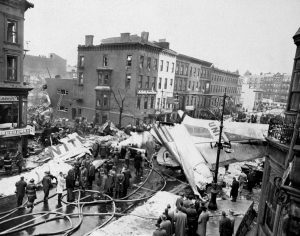
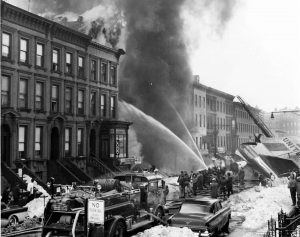 top floor apartment when the place crashed into her building, later said “The roof caved in and I saw the sky.” Six people on the ground died when the plane crashed, including the 90 year old caretaker of the church, Wallace Lewis, and two men who were selling Christmas trees nearby. Christmas presents carried by the plane’s passengers were strewn all over the streets. Firefighting efforts went on for nearly 72 hours because of the multiple fires.
top floor apartment when the place crashed into her building, later said “The roof caved in and I saw the sky.” Six people on the ground died when the plane crashed, including the 90 year old caretaker of the church, Wallace Lewis, and two men who were selling Christmas trees nearby. Christmas presents carried by the plane’s passengers were strewn all over the streets. Firefighting efforts went on for nearly 72 hours because of the multiple fires.

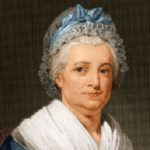 When we think of dinners with the President of the United States, we think of state dinners with tons of security, and massive pre-planning. Presidential dinners have changed distinctly since Washington’s day. The nation was much smaller for sure, and he could easily get together with all of his advisors and Congress in one place, I’m sure. In fact, George Washington was basically in uncharted waters. So, he decided that on Thursday evenings, he would have the brightest minds in the nation over for a casual dinner. At that time the nation’s capitol was still in New York City, so those casual dinners were never held in the White House. George Washington and his family lived in executive mansions in lower Manhattan, which was close to other governmental buildings in that era. While Washington entertained foreign dignitaries and other heads of state at public receptions on Tuesdays and Martha Washington regularly invited guests to their home on Fridays, Thursday evenings were reserved for formal dinners with congressional leaders, their wives and close personal friends of the Washingtons.
When we think of dinners with the President of the United States, we think of state dinners with tons of security, and massive pre-planning. Presidential dinners have changed distinctly since Washington’s day. The nation was much smaller for sure, and he could easily get together with all of his advisors and Congress in one place, I’m sure. In fact, George Washington was basically in uncharted waters. So, he decided that on Thursday evenings, he would have the brightest minds in the nation over for a casual dinner. At that time the nation’s capitol was still in New York City, so those casual dinners were never held in the White House. George Washington and his family lived in executive mansions in lower Manhattan, which was close to other governmental buildings in that era. While Washington entertained foreign dignitaries and other heads of state at public receptions on Tuesdays and Martha Washington regularly invited guests to their home on Fridays, Thursday evenings were reserved for formal dinners with congressional leaders, their wives and close personal friends of the Washingtons.
In reality, these dinners were elaborate affairs. They started promptly at 4:00pm, because Washington refused to wait for latecomers. I guess every president has his own idiosyncrasies. The parties numbered up to two dozen people, gathered around a table set with the Washington family silver and china. Unlike some state dinners, in which the President and his wife occupy the head of the table, Martha Washington preferred to sit in the middle of one side of the long table and President Washington sat directly across from her. The ends of the table were occupied by a secretary to help with the conversation and roast carving. The roast carving was necessary too, because there were a lot of roasts to be carved. The dinners were comprised of three courses, but that did no limit the selection. There would commonly be upwards of twenty different dishes in each course…all of which were brought to the table at the same time.
The various dishes were the finest that New York had to offer, and the guests were lavished with the exquisite meals. Manhattan was in the middle of New York City, but in 1700, it was still quite wild. The island had an assortment of venison, rabbit, and duck that were hunted for food. Oysters were abundant in the Hudson River. Jellies, dried fruits and nuts were served alongside, although you wouldn’t have seen potato or tomato dishes, because those foods were regarded as unfit for humans to eat in those days. Wine was drunk with dinner, although George Washington was said to prefer a tankard of ale over a glass of claret.
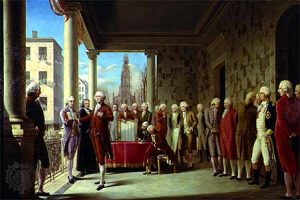
When dinner was over, Washington would raise a toast to the assembly, and then the ladies would retire to Martha’s drawing room for “coffee and civilized conversation.” The gentlemen would remain in the dining room, lingering over cigars and wine, but not for very long. The president only stayed another thirty minutes before joining the women in the drawing room. One of his personal secretaries would stay on in the dining room with the men to preside over political chats for another hour or so, until the company left and the Washingtons’ Thursday dinner was over…until the next week. George Washington passed away on this day, December 14, 1799.
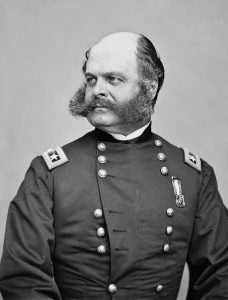 Those who have studied the Civil War, or know much about the United States at all, know that the Civil War was won by the Union, but that does not mean that there weren’t battles that they lost. There are very few wars that are lopsided in their battle field victories. One such battle was the Battle of Fredericksburg. On December 11, 1862, Ambrose Burnside, newly placed in command of the Army of the Potomac, planned to cross the Rappahannock River in Virginia with over 120,000 troops. When he finally crossed it, two days later, on December 13, 1862, he confronted 80,000 troops of Robert E Lee’s Confederate Army at Fredericksburg. With 200,000 combatants, this was the largest concentration of troops of any Civil War Battle. It was also one of the battles the Union Army would lose. In a crushing defeat, the Union Army suffered nearly 13,000 casualties, while the Confederate Army only lost 5,000.
Those who have studied the Civil War, or know much about the United States at all, know that the Civil War was won by the Union, but that does not mean that there weren’t battles that they lost. There are very few wars that are lopsided in their battle field victories. One such battle was the Battle of Fredericksburg. On December 11, 1862, Ambrose Burnside, newly placed in command of the Army of the Potomac, planned to cross the Rappahannock River in Virginia with over 120,000 troops. When he finally crossed it, two days later, on December 13, 1862, he confronted 80,000 troops of Robert E Lee’s Confederate Army at Fredericksburg. With 200,000 combatants, this was the largest concentration of troops of any Civil War Battle. It was also one of the battles the Union Army would lose. In a crushing defeat, the Union Army suffered nearly 13,000 casualties, while the Confederate Army only lost 5,000.
People might think that Burnside was not much of a commander, but it should be mentioned that this was the first time he had commanded an army. He was a graduate of West Point, had risen quickly up the ranks, and had seen action in several battles prior to this fateful day. Abraham Lincoln had approached him about taking control of the Union’s Army. He hesitated, partly out of loyalty to the current commander and former classmate, and partly because he was unsure of his own ability. In the end the prior commander’s failure assured that he was on the way out, and rather than have Major General Joseph Hooker, a fierce rival, pass him up, Burnside accepted the commission on November 7, 1862.
Knowing that he had to have the element of surprise, Burnside came up with a plan to confront Lee’s Army of Northern Virginia at Fredericksburg. He planned to move his forces to the banks of the neighboring Rappahannock River, and then transport his men across by way of hastily assembled pontoon bridges, and surprise the enemy. Lincoln was impressed with the audacity of the plan and approved it, but expressed doubts about its potential for success. Burnside swung into action, reaching the banks of the Rappahannock by November 19, 1862. We will never know if the plan might have succeeded, if some Union generals, including Winfield Scott Hancock, who believed the river could be crossed without the boats, had sent the boats…but instead, they urged Burnside to act without them. Burnside, who believed the river was too swift and deep, refused. They waited a week for the boats…unfortunately, under the watchful eyes of the Confederate scouts.
The element of surprise was gone. When they finally began building the pontoon bridges, the Confederate Army opened fire. Burnside began a massive bombardment of Fredericksburg, in the first shelling of a city in the Civil War. They were able to hold back the Confederate Army long enough to finish the bridges, and then they rushed across the river. Two days later, Burnside ordered his left flank to attack Lee’s right, in the hopes that Lee would have to divert forces to the south of the city, leaving the center and Marye’s Heights vulnerable. For a few hours, it looked like this might actually work. General George Meade broke through “Stonewell” Jackson’s line, but the Union failed to send in enough reinforcements to prevent a successful Confederate counterattack. Lee was able to keep James Longstreet’s men in position at Marye’s Heights, where they decimated Union forces. Burnside lost eight men for every Confederate soldier lost there. Though Burnside briefly considered another assault, the battle was over. The Union had suffered nearly 13,000 casualties while the Confederates lost fewer than 5,000. They needed to regroup before attacking again.
Burnside was an unpopular commander, partly I’m sure, because he felt the need to rush into things without really planning them out. His feelings of inadequacy proved to be his downfall. As he was planning his next attack, some of his leaders went to President Lincoln to voice their concerns. In the end, Lincoln halted the attack. On January 20, 1983, Burnside was ready to go again, but again the pontoon bridges were delayed. The weather didn’t help things either. What had been a dry January turned rainy, and the roads were all but impassible. Troops that had covered 40 miles a day on their way to Fredericksburg now struggled to get further than a mile. For three days, Burnside’s troops continued their disastrous slog on what would become known as the “Mud March,” accompanied most of the way by jeering Confederate forces taunting them from dry land. Five days after his offensive began, it was over…and so was Burnside’s brief, six week stint as commander of the Army of the Potomac. Lincoln immediately removed him from command, replacing him with the very person he feared it would be…Joseph Hooker.
Fredericksburg was the low point in the war for the North, but the South was ecstatic. Burnside probably should have stuck to his side career…weaponry design. And that was what he went back to. He retired in 1853 and in 1856 received his first patent for a .54 caliber breech loading firearm. Impressed with the carbine’s performance, the U.S. Army awarded the Bristol Firearm Company in Rhode Island…where Burnside worked…with a $100,000 contract. The order was soon rescinded, however, under shady circumstances. It’s believed that a rival munitions company bribed the army ordinance department to switch suppliers. Burnside’s bad luck continued the next year when a failed bid for a Congressional seat, followed closely by a fire that destroyed the Bristol factory, forced the financially strapped Burnside to sell his patents. Others would reap the rewards  when, at the start of the Civil War, demand for his creation soared. By 1865, more than 55,000 carbines had been ordered, and the Burnside had become one of the most popular Union weapons of the war, second only to the Sharp carbine and my ancestor, Christopher Spencer’s Spencer carbine.
when, at the start of the Civil War, demand for his creation soared. By 1865, more than 55,000 carbines had been ordered, and the Burnside had become one of the most popular Union weapons of the war, second only to the Sharp carbine and my ancestor, Christopher Spencer’s Spencer carbine.
Burnside would eventually have a claim to fame, but it would not be for war or weapons. Burnside liked to wear his facial hair in what was an unusual way for the times. He had a bushy beard and moustache along with a clean-shaven chin. These distinctive whiskers were originally dubbed “burnsides,” but later the term would be altered and would become “sideburns.”
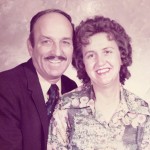
 Nine years ago today, my world, and that of my mom and sisters was turned upside down when Dad left us to go to Heaven. I don’t think we will ever feel like things on Earth are normal again, because obviously, normal for us was having him in our lives on a daily basis. It’s hard to pass this day without feeling a sense of loss…no matter how many years have passed, because all that’s left to us are the memories.
Nine years ago today, my world, and that of my mom and sisters was turned upside down when Dad left us to go to Heaven. I don’t think we will ever feel like things on Earth are normal again, because obviously, normal for us was having him in our lives on a daily basis. It’s hard to pass this day without feeling a sense of loss…no matter how many years have passed, because all that’s left to us are the memories.
Memories of childhood days come up in my memory first. The many camping trips our parents took us on, and the things we saw, and learned, and did. It was Dad that taught us how to read a map by taking out the atlas and allowing us to help map out our trips. My friends had no idea how to read a map, and while I use GPS these days, I can read a map without any trouble. It was Dad who taught us to build a campfire, and we who taught him that girls are sure that if Dad puts another log on the fire, the bears will stay away. It was Dad who filled us with the wonders our great nation had to offer by taking his family all over the country, and showing us things like the Statue of Liberty, the Grand Canyon, Washington DC, the Black Hills, Glacier National Park, Yellowstone National Park, the Atlantic and Pacific Oceans, and so much more. Our summer vacations were filled with adventure, and we knew that we were very blessed.
As we grew, our relationship obviously changed, but the values that Dad, and Mom too, taught us remained. Dad was always one to live by the Biblical principle, “Never let the sun go down on your wrath,” and so if we argued with each other, or our parents, Dad would be the one to come to us and tell us that we had to make up before the day ended. We may not have felt like doing so, but we obeyed Dad, because he was our dad. I can’t say that I have ever regretted making up with my family, although I may not have liked it at the time. It was what kept our family close. Dad knew the importance of forgiveness, and instilled that in us too.
As my parents grew older, time was the top priority for them. They wanted their daughters to come over…often, to spend time with them. And they wanted the grandchildren to come too. Their family was the top priority, and they wanted us to know how much we meant to them. Lunches spent at their house, with all the 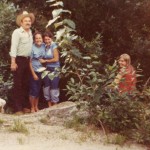
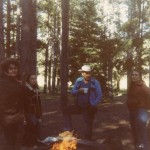 girls talking, and Dad barely getting a word in edgewise, were the normal things in their house. I don’t think Dad really minded that either. He loved hearing the voices and the laughter of his girls, and seeing their smiling faces. Dad was all about family, and I will never regret the lunches and evenings spent there, because that was when blessings took on the feeling of warmth. It saddens me that my dad has been gone for nine years now, and all that’s left are the memories…but I am very thankful for those memories, because they are what keeps him close. We love and miss you so much Dad.
girls talking, and Dad barely getting a word in edgewise, were the normal things in their house. I don’t think Dad really minded that either. He loved hearing the voices and the laughter of his girls, and seeing their smiling faces. Dad was all about family, and I will never regret the lunches and evenings spent there, because that was when blessings took on the feeling of warmth. It saddens me that my dad has been gone for nine years now, and all that’s left are the memories…but I am very thankful for those memories, because they are what keeps him close. We love and miss you so much Dad.
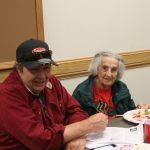
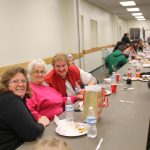 With each passing year, I find myself looking forward more and more to the Byer Family Christmas Party. Sadly, I think that part of the reason is that as time passes, we seem to lose more and more of my aunts and uncles. This year found us with only four aunts and only one uncle at the party. There are other uncles who are still alive, but that aren’t really able to come out for these events any more. It makes each time we get together that much more precious. I always feel sorry for those who didn’t make it to the party, because we always have such a nice time, and we are a family of excellent cooks, so the food is fabulous. And it is a way to keep those who have gone to Heaven just a little closer to the family. Nevertheless, the sadness over missing those who have left us persists, and grows with each new passing.
With each passing year, I find myself looking forward more and more to the Byer Family Christmas Party. Sadly, I think that part of the reason is that as time passes, we seem to lose more and more of my aunts and uncles. This year found us with only four aunts and only one uncle at the party. There are other uncles who are still alive, but that aren’t really able to come out for these events any more. It makes each time we get together that much more precious. I always feel sorry for those who didn’t make it to the party, because we always have such a nice time, and we are a family of excellent cooks, so the food is fabulous. And it is a way to keep those who have gone to Heaven just a little closer to the family. Nevertheless, the sadness over missing those who have left us persists, and grows with each new passing.
I think one reason that our grandparents wanted their children to continue the annual Christmas party and annual picnic was so that we would all get to know each other better. As the new generations come along. It would be so easy to lose touch with each other. That would be so sad, because little kids are usually instant 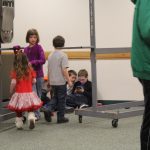
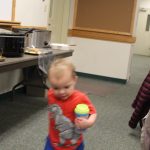
 friends, and that makes it extra special to watch. The kids had a sparkle in their eyes, and smiles on their faces. They were so excited to have new friends to play with and lots of room to run around, with no one to get upset at them. For kids, Christmas is always a special time of year, and it’s really hard to hold back the excitement. I love watching them bounce around the room. I could say that they ran around the room, but that wouldn’t be right exactly, because they really did bounce with excitement, and after all, it’s all about the kids right.
friends, and that makes it extra special to watch. The kids had a sparkle in their eyes, and smiles on their faces. They were so excited to have new friends to play with and lots of room to run around, with no one to get upset at them. For kids, Christmas is always a special time of year, and it’s really hard to hold back the excitement. I love watching them bounce around the room. I could say that they ran around the room, but that wouldn’t be right exactly, because they really did bounce with excitement, and after all, it’s all about the kids right.
My grandparents were wise people. They had a vision for their kids and grandkids…for all of the generations that would follow them. They knew how easy it is to get busy in life, and to lose touch with family. It happens 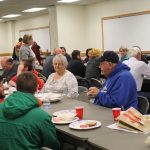
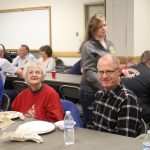 in so many families, and they didn’t want that for their family. Very wise people indeed. They wanted their kids not only to know their nieces and nephews, but also their grand nieces and nephews, and great grand nieces and nephews, for as long as they lived. What a precious gift that request turned out to be. It was not a burden to be carried or work to be done…it was a gift, and one I am thankful for every single year. It’s a time for family and reconnecting. While we miss all those who are gone now, I know that they would be proud of us for continuing this tradition. We love you all.
in so many families, and they didn’t want that for their family. Very wise people indeed. They wanted their kids not only to know their nieces and nephews, but also their grand nieces and nephews, and great grand nieces and nephews, for as long as they lived. What a precious gift that request turned out to be. It was not a burden to be carried or work to be done…it was a gift, and one I am thankful for every single year. It’s a time for family and reconnecting. While we miss all those who are gone now, I know that they would be proud of us for continuing this tradition. We love you all.

 My nephew, Barry Schulenberg, and his wife, Kelli have been doing some remodeling on their bathroom and their home outside of Casper, Wyoming. Barry has a knack for carpentry, and that reminds me of the little boy that was Barry, helping his grandpa, my father-in-law, Walt Schulenberg build the family home north of Casper. It seems like so many years ago, and yet in my memory files, I can see it so clearly. In those days, Barry wanted to do anything his grandpa was doing…so much so, in fact, that Barry had decided that he didn’t need to go to school. He was just going to go to work with his grandpa. I can’t say exactly how much Barry learned about carpentry from his grandpa in those days, but I think he took something away from that experience, even as a little two year old boy. I think he found that he liked to build things, but more than that, it built a bond between grandfather and grandson that would last a lifetime.
My nephew, Barry Schulenberg, and his wife, Kelli have been doing some remodeling on their bathroom and their home outside of Casper, Wyoming. Barry has a knack for carpentry, and that reminds me of the little boy that was Barry, helping his grandpa, my father-in-law, Walt Schulenberg build the family home north of Casper. It seems like so many years ago, and yet in my memory files, I can see it so clearly. In those days, Barry wanted to do anything his grandpa was doing…so much so, in fact, that Barry had decided that he didn’t need to go to school. He was just going to go to work with his grandpa. I can’t say exactly how much Barry learned about carpentry from his grandpa in those days, but I think he took something away from that experience, even as a little two year old boy. I think he found that he liked to build things, but more than that, it built a bond between grandfather and grandson that would last a lifetime.
Over the years, Barry helped his grandfather do anything he was doing. From splitting wood to working on cars, the two of them were almost inseparable, except for the inevitable job/school times that each had to go to. Barry lived for the time when his grandpa would be home from work and they could go work outside. I’m not sure if my father-in-law felt worn out or not, but if he did, he rarely showed it to Barry. They were best buddies and that was all that mattered. The three granddaughters that my father-in-law had then, were his little princesses, and were treated as such, but Barry was his working buddy, and that was just the way it was. I think the girls were ok with that too, because carpentry and cars really weren’t their idea of fun anyway.
I don’t know if Barry realized how special his relationship with his grandpa was, but I really hope he did or does now, because it was special. Not every little boy gets to spend the time with their grandfather that Barry did. That was a blessing beyond blessings for both of them, and it was special to watch too. My father-in-law has 
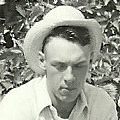 been gone now for over three and a half years now. I have to wonder if Barry misses his grandpa as he is working on the current project he has set himself to now. It’s not that Barry can’t do the work himself and with Kelli’s help, but I have to wonder if he doesn’t hear the echo of his grandpa’s voice guiding him through the steps to remodeling the bathroom. His grandpa really knew what he was doing, and to top it off, Barry looks like his grandpa too. No wonder they got along so well. They were two of a kind. Today is Barry’s birthday. Happy birthday Barry!! Have a great day!! We love you!!
been gone now for over three and a half years now. I have to wonder if Barry misses his grandpa as he is working on the current project he has set himself to now. It’s not that Barry can’t do the work himself and with Kelli’s help, but I have to wonder if he doesn’t hear the echo of his grandpa’s voice guiding him through the steps to remodeling the bathroom. His grandpa really knew what he was doing, and to top it off, Barry looks like his grandpa too. No wonder they got along so well. They were two of a kind. Today is Barry’s birthday. Happy birthday Barry!! Have a great day!! We love you!!
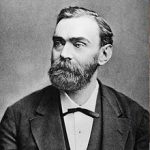 When Alfred Bernhard Nobel, the Swedish inventor of dynamite and other high explosives, died on December 10, 1896, he left a request in his will, that the bulk of his vast fortune be placed in a fund to finance an award to be “annually distributed in the form of prizes to those who, during the preceding year, shall have conferred the greatest benefit on mankind.” He did not state why he wanted to make such a bequest, but it was believed that he did so out of moral regret over the increasingly lethal uses of his inventions in war. The first Nobel Prizes are awarded in Stockholm, Sweden, in the fields of physics, chemistry, medicine, literature, and peace. The ceremony came on the fifth anniversary of Nobel’s death.
When Alfred Bernhard Nobel, the Swedish inventor of dynamite and other high explosives, died on December 10, 1896, he left a request in his will, that the bulk of his vast fortune be placed in a fund to finance an award to be “annually distributed in the form of prizes to those who, during the preceding year, shall have conferred the greatest benefit on mankind.” He did not state why he wanted to make such a bequest, but it was believed that he did so out of moral regret over the increasingly lethal uses of his inventions in war. The first Nobel Prizes are awarded in Stockholm, Sweden, in the fields of physics, chemistry, medicine, literature, and peace. The ceremony came on the fifth anniversary of Nobel’s death.
Educated in private schools in Saint Petersburg, Russia, Nobel excelled in Swedish, Russian, French, English and German. His primary interests were in English literature and poetry as well as in chemistry and physics. His interest in literature and poetry, was upsetting to his father, who considered him an introvert. He wanted his sons to become engineers, and to join his enterprise. In an effort to redirect Alfred’s interests, his father sent him abroad for further training in chemical engineering. During a two year period Alfred Nobel visited Sweden, Germany, France and the United States. In Paris, the city he came to like best, he worked in the private laboratory of Professor T J Pelouze, a famous chemist. There he met the young Italian chemist Ascanio Sobrero who, three years earlier, had invented nitroglycerine, a highly explosive liquid. Alfred Nobel proved himself to be a brilliant chemist. When his father’s business faltered after the end of the Crimean War, Nobel returned to Sweden and set up a laboratory to experiment with explosives. In 1863, he invented a way to control the detonation of nitroglycerin, which was previously regarded as too dangerous for use. Two years later, Nobel invented the blasting cap, an improved detonator that brought about the modern use of high explosives. Previously, the most dependable explosive was black powder, a form of gunpowder. Nitroglycerin remained dangerous, however, and in 1864 Nobel’s nitroglycerin factory blew up, killing his younger brother and several other people. Searching for a safer explosive, Nobel discovered in 1867 that the combination of nitroglycerin and a porous substance called Kieselguhr produced a highly explosive mixture that was much safer to handle and use. Nobel called his invention “dynamite,” for the Greek word dynamis, meaning “power.” Securing patents on dynamite, Nobel acquired a fortune as humanity put his invention to use in construction and warfare. Over his lifetime Alfred Nobel earned 355 patents.
All his work, left little time for a social life. At 43 years of age, feeling lonely and old, he placed an add for a woman who might become a suitable mate for him. The only one who came close to being the one, was Countess Bertha Kinsky, unfortunately she returned home and married Count Arthur von Suttner, but she and Nobel remained friends and kept writing letters to each other for decades. Over the years Bertha von Suttner became increasingly critical of the arms race. She wrote a famous book, Lay Down Your Arms and became a prominent figure in the peace movement. No doubt this influenced Alfred Nobel when he wrote his final will which was to include a Prize for persons or organizations who promoted peace. Several years after the death of Alfred Nobel, the Norwegian Parliament decided to award the 1905 Nobel Peace Prize to Bertha von Suttner.
The first Nobel Prizes were awarded on December 10, 1901, and subsequent prizes are awarded each year on 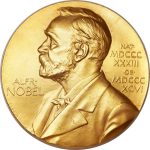 December 10, because it is the anniversary of Alfred Nobel’s death. It is the perfect day for the awards to be given. The Royal Swedish Academy of Sciences decides the prizes in physics, chemistry, and economic science. The Swedish Royal Caroline Medico-Surgical Institute determines the physiology or medicine award. The Swedish Academy chooses literature, and a committee elected by the Norwegian parliament awards the peace prize. In 2006, each Nobel Prize carried a cash prize of nearly $1,400,000 and recipients also received a gold medal, as is the tradition. Some notable winners have included Marie Curie, Theodore Roosevelt, Albert Einstein, George Bernard Shaw, Winston Churchill, Ernest Hemingway, Martin Luther King Jr, the Dalai Lama, Mikhail Gorbachev, and Nelson Mandela. All made Nobel efforts in their field.
December 10, because it is the anniversary of Alfred Nobel’s death. It is the perfect day for the awards to be given. The Royal Swedish Academy of Sciences decides the prizes in physics, chemistry, and economic science. The Swedish Royal Caroline Medico-Surgical Institute determines the physiology or medicine award. The Swedish Academy chooses literature, and a committee elected by the Norwegian parliament awards the peace prize. In 2006, each Nobel Prize carried a cash prize of nearly $1,400,000 and recipients also received a gold medal, as is the tradition. Some notable winners have included Marie Curie, Theodore Roosevelt, Albert Einstein, George Bernard Shaw, Winston Churchill, Ernest Hemingway, Martin Luther King Jr, the Dalai Lama, Mikhail Gorbachev, and Nelson Mandela. All made Nobel efforts in their field.
 Sometimes, there are events in history that end up tied to other events in history, in one way or another. On this day, December 9, 2003, Tehran, Iran was hit by unseasonably cold temperature, that led to the deaths of 40 people from hypothermia. It is very rare to see such large groups of people die in this way at the same time, but it does happen, as seen in Tehran. Their deaths occurred when their core body temperature fell to 77 degrees Fahrenheit. So, how does this have anything to do with history beyond 2003? Well, it actually does, and not in a good way.
Sometimes, there are events in history that end up tied to other events in history, in one way or another. On this day, December 9, 2003, Tehran, Iran was hit by unseasonably cold temperature, that led to the deaths of 40 people from hypothermia. It is very rare to see such large groups of people die in this way at the same time, but it does happen, as seen in Tehran. Their deaths occurred when their core body temperature fell to 77 degrees Fahrenheit. So, how does this have anything to do with history beyond 2003? Well, it actually does, and not in a good way.
Most of us, these days, know about hypothermia. In fact, the causes and the fixes are pretty well known, but what I didn’t know before, although maybe I should have, is that the information we have on hypothermia came from the horrible experiments that the Nazis performed on the prisoners at the Dachau concentration camp during World War II. These unethical medical experiments that were carried out during the Third Reich fell into three categories. The first category consists of experiments aimed at facilitating the survival of Axis military personnel. In Dachau, physicians from the German air force and from the German Experimental Institution for Aviation conducted high-altitude experiments, using a low-pressure chamber, to determine the maximum altitude from which crews of damaged aircraft could parachute to safety. Scientists there carried out so-called freezing experiments using prisoners to find an effective treatment for hypothermia. While the findings might have been a good thing, the way the experiments were carried out was horrendous. After these experiments, most people knew that if they were  outside in frigid temperatures, they could die of hypothermia. Nevertheless, there were a few miracle situations, such as the two year old girl in Canada in 1994, who survived after her core body temperature dropped to 57 degrees Fahrenheit when she wandered away from her home in Saskatchewan.
outside in frigid temperatures, they could die of hypothermia. Nevertheless, there were a few miracle situations, such as the two year old girl in Canada in 1994, who survived after her core body temperature dropped to 57 degrees Fahrenheit when she wandered away from her home in Saskatchewan.
The second category of experimentation involved developing and testing pharmaceuticals and treatment methods for injuries and illnesses which German military and occupation personnel encountered in the field. Apparently the Nazis felt free to find ways to save their soldiers lives, at the expense of their prisoners. At the German concentration camps of Sachsenhausen, Dachau, Natzweiler, Buchenwald, and Neuengamme, prisoners were subjected to immunization compounds for the prevention and treatment of contagious diseases, including malaria, typhus, tuberculosis, typhoid fever, yellow fever, and infectious hepatitis. The Ravensbrueck camp was the site of bone-grafting experiments and experiments to test the efficacy of newly developed sulfanilamide drugs. At Natzweiler and Sachsenhausen, scientists tested prisoners with phosgene and mustard gas in order to find possible antidotes. Their lives simply didn’t matter when it came to the experimentation.
The third category of medical experimentation sought to advance the racial and ideological principles of the Nazi worldview. The most infamous were the experiments of Josef Mengele at Auschwitz. Mengele conducted medical experiments on twins. He also directed serological experiments on Roma Gypsies, as did Werner  Fischer at Sachsenhausen, in order to determine how different “races” withstood various contagious diseases. The research of August Hirt at Strasbourg University also intended to establish “Jewish racial inferiority.” Other gruesome experiments meant to further Nazi racial goals were a series of sterilization experiments, undertaken primarily at Auschwitz and Ravensbrueck. There, scientists tested a number of methods in their effort to develop an efficient and inexpensive procedure for the mass sterilization of Jews, Roma Gypsies, and other groups that the Nazi leaders considered to be racially or genetically undesirable. It is difficult for me to even think about the cruelty that the Nazis inflicted on the Jews and Gypsies during those horrible years.
Fischer at Sachsenhausen, in order to determine how different “races” withstood various contagious diseases. The research of August Hirt at Strasbourg University also intended to establish “Jewish racial inferiority.” Other gruesome experiments meant to further Nazi racial goals were a series of sterilization experiments, undertaken primarily at Auschwitz and Ravensbrueck. There, scientists tested a number of methods in their effort to develop an efficient and inexpensive procedure for the mass sterilization of Jews, Roma Gypsies, and other groups that the Nazi leaders considered to be racially or genetically undesirable. It is difficult for me to even think about the cruelty that the Nazis inflicted on the Jews and Gypsies during those horrible years.
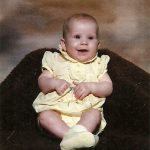
 Life is a series of changes, because nothing ever stays the same here on Earth…that’s just the way it is. Three months ago, my niece, Jessi Sawdon, and her husband Jason became parents for the first time, to Adelaide Ione…AKA Jessi’s mini me, although I’m told she looks a lot like her daddy too, but those eyes are all Jessi. Jessi and Jason are having the time of their lives with their precious little girl, and they are going to be such great parents. They are loving and fun, yet disciplined, and they love their baby girl so much. Those are the most important qualities in a parent anyway…right. Jessi has always been a joyful girl. In fact she and her siblings are all that way, and so Jessi grew up in a home filled with laughter, and so did Jason, so that is the type of home they have now. Nevertheless, Jessi has always had a soft side too. She is very gentle and loving, and her little Adelaide simply beams when her mommy is talking to her.
Life is a series of changes, because nothing ever stays the same here on Earth…that’s just the way it is. Three months ago, my niece, Jessi Sawdon, and her husband Jason became parents for the first time, to Adelaide Ione…AKA Jessi’s mini me, although I’m told she looks a lot like her daddy too, but those eyes are all Jessi. Jessi and Jason are having the time of their lives with their precious little girl, and they are going to be such great parents. They are loving and fun, yet disciplined, and they love their baby girl so much. Those are the most important qualities in a parent anyway…right. Jessi has always been a joyful girl. In fact she and her siblings are all that way, and so Jessi grew up in a home filled with laughter, and so did Jason, so that is the type of home they have now. Nevertheless, Jessi has always had a soft side too. She is very gentle and loving, and her little Adelaide simply beams when her mommy is talking to her.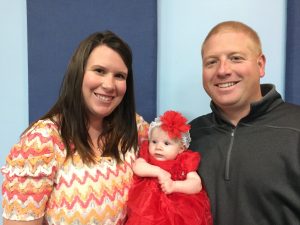
The Bible says, “As you sow, so shall you reap.” When someone has a child, that verse tends to come to mind, because if the parent was a difficult child, they start wondering if their child will be too. With Jessi, who was for the most part, a pretty easy going child, that verse brings one thing to mind. When Jessi was a little two year old girl, her mother, my sister, Allyn Hadlock used to play games with Jessi. One of them was a playful way of saying, “no-no.” She would shake her finger at little Jessi and say, “Don’t you ever do that.” She would also tell her, “I’m the mom, you’re the baby.” Jessi knew that her mother wasn’t terribly serious, but when the tables turned, it was a little different. Once when Allyn was telling Jessi that she was the mom, Jessi argued that, no, she was the mom. As the “argument” progressed, my dinky little niece raised her arm up in the air toward her mom, pointed her finger down for whatever reason, and told her mom, “Don’t you ebber!!” Well, Allyn couldn’t have been mad are her if it had been a real argument, but I have to wonder if one of these days, a determined little Adelaide won’t tell her mom, “Don’t you ebber!!” Or maybe something similar anyway.


As the song goes, “Life’s about changing, nothing ever stays the same,” but when you think about it, maybe we wouldn’t really want it to, because if it did, we wouldn’t have some of those silly little moments that come from our children, and later, our grandchildren. Jessi and Jason’s lives are changing every day, and while I’m sure it will be a wild ride at times, it will also be an amazing one. I’m sure it will change again as more children come along too. Today is Jessi’s birthday. Happy birthday Jessi!! Have a great day!! We love you!!

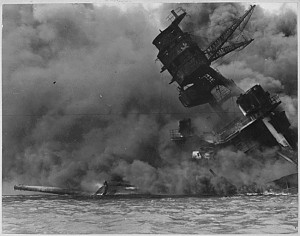 Whether people remember the date or not, I think that most people know that the attack on Pearl Harbor was what took the United States into World War II. Negotiations with Japan had broken down, and President Franklin Roosevelt and his advisors knew that in all probability, the Japanese would attack the United States. Still, nothing was done to increase security at key points, like the naval base at Pearl Harbor, Hawaii. This was especially an important base, because of it’s location. It was a place that early warning could have been given to the mainland, or where an attack could have been thwarted, but as often happens in government, the leaders don’t want to scare the nation, so they try to keep things from them…a plan the is fraught with folly. The best weapon a nation can possibly have is preparedness.
Whether people remember the date or not, I think that most people know that the attack on Pearl Harbor was what took the United States into World War II. Negotiations with Japan had broken down, and President Franklin Roosevelt and his advisors knew that in all probability, the Japanese would attack the United States. Still, nothing was done to increase security at key points, like the naval base at Pearl Harbor, Hawaii. This was especially an important base, because of it’s location. It was a place that early warning could have been given to the mainland, or where an attack could have been thwarted, but as often happens in government, the leaders don’t want to scare the nation, so they try to keep things from them…a plan the is fraught with folly. The best weapon a nation can possibly have is preparedness.
December 7, 1941 was a beautiful Sunday in Hawaii, 75 years ago today, and many military personnel had been given passes to attend church services off base. At 7:02am, two radar operators spotted large groups of aircraft in flight toward the island from the north, but with a flight of B-17s expected from the United States at the time, they were told not to sound an alarm. At 7:55am Hawaii time, a Japanese dive bomber bearing the red symbol of the Rising Sun of Japan on its wings appeared out of the clouds above the island of Oahu. Behind it came a swarm of 360 Japanese warplanes, descending on the US naval base at Pearl Harbor in a ferocious attack. The United States was unprepared, and the surprise attack struck a critical blow against the US Pacific fleet drawing the United States irrevocably into World War II.
In an attack that lasted just under two hours, the Japanese rendered much of the Pacific fleet useless, including five of eight battleships, three destroyers, and seven other ships that were sunk or severely damaged, and more than 200 aircraft that were destroyed. A total of 2,400 Americans were killed and 1,200 were wounded, many while scrambling in a valiant attempt to repulse the attack. Japan’s losses were some 30 planes, five midget submarines, and fewer than 100 men. Fortunately for the United States, all three Pacific fleet carriers were out at sea on training maneuvers. These giant aircraft carriers would exact their revenge against Japan six months later at the Battle of Midway, reversing the tide against the previously invincible Japanese navy in a spectacular victory…a beating that Japan would not forget.
The day after Pearl Harbor was bombed, President Roosevelt appeared before a joint session of Congress and declared, “Yesterday, December 7, 1941…a date which will live in infamy…the United States of America was suddenly and deliberately attacked by naval and air forces of the Empire of Japan.” After a brief and forceful speech, he asked Congress to approve a resolution recognizing the state of war between the United States and Japan. The Senate voted for war against Japan by 82 to 0, and the House of Representatives approved the resolution by a vote of 388 to 1. The sole dissenter was Representative Jeannette Rankin of Montana, a devout pacifist, who had also cast a dissenting vote against the United States entrance into World War I. Three days later, Germany and Italy declared war against the United States, and the United States government responded in kind. The American contribution to the successful Allied war effort spanned four long years and cost more than 400,000 American lives.
I have never personally been to Pearl Harbor, but I am told that the Arizona Memorial, that stands above the sunken ship, that is grave to the brave men who died inside, displays a feeling of sadness, and of being on 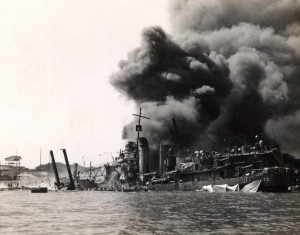
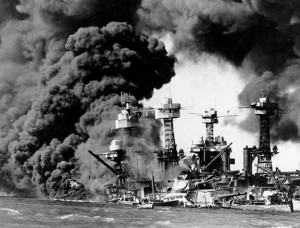 hallowed ground. It is a feeling I felt when I walked through the cemetery at Gettysburg. The men who died there…who bravely gave the ultimate sacrifice deserve the respect of those who would come to visit. I do not believe in ghosts, but I do believe that God gives cemeteries, in general, and military cemeteries especially an air of quiet honor reserved for the dead. Let us never forget that our greatest weapon in all areas of life is preparedness.
hallowed ground. It is a feeling I felt when I walked through the cemetery at Gettysburg. The men who died there…who bravely gave the ultimate sacrifice deserve the respect of those who would come to visit. I do not believe in ghosts, but I do believe that God gives cemeteries, in general, and military cemeteries especially an air of quiet honor reserved for the dead. Let us never forget that our greatest weapon in all areas of life is preparedness.

